| |
|

May
5
Up early (03:30) for Trevor (shuttle service) to drive me to
the airport for an early flight to Johannesburg (two hours) and another
flight (1 & ½ hours) to Harare, where I was met by my youngest
niece Lindsay and her husband Nevin, at 11:30. Several huge posters
welcomed travelers to Harare, with the smiling face of a young woman,
who was very lightly coloured. Why can’t Zimbabweans – and other dark
skinned people – be “Proud to be Black” ?
Drove
on the Mutare (Umtali) road, Nevin drawing my attention to the almost
complete absence of birds. On the outskirts of Harare there used to
be large vleis, which attracted thousands of seed-eating birds. But
now the vleis have been
taken over by maize fields – not surprising when there is so much
hunger. Still, it would be a pity if the next generation
never saw the colourful Red Bishop, and other avian seasonal
visitors. The widespread use of catapults, by men and boys, also wreaks
havoc among the birds. Certainly we saw hardly any bird life.
We
passed Marondera (Marandellas) still a neat little town. I wondered
why some small towns are shabby and in disrepair, looking very neglected,
with gangs of not very friendly youths patrolling the streets, while
others remain in good order.
We stopped at a wayside Café, looking for a snack. I was tempted
by a ham roll, but Lindsay dissuaded me, pointing out that, with
the frequent power cuts, it was best to avoid meat.
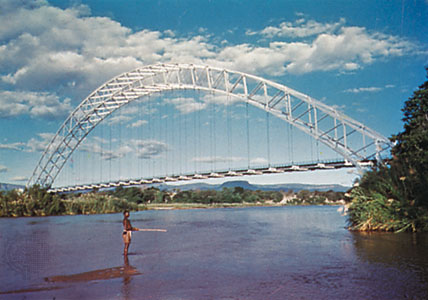 Birchenough Bridge
Birchenough Bridge
About
100 kms beyond Mutare is the graceful Birchenough Bridge, which,
when built in 1935, was the third largest single-span suspension bridge
in the world. The same designer later built the Sydney Harbour bridge,
which is similar in construction, but half again as long. 20 kms before
the bridge we passed the notorious alluvial diamond fields, discovered
a few years ago, and appropriated by the government;
these are said to be among the richest diamond areas in the
world. Local miners were told to clear out, but some returned, and
were attacked ; impossible to be sure how many were killed, but good
sources told me that at least 74 bodies were brought to the Mutare
morgue, after having been shot at by soldiers in helicopters.
This
is Baobab country, all the trees near the road having been ring barked
up to about 2m, the women making colourful mats, which were on sale.
Boys also sold baobab pods –“cream of tartar”- which are very popular
eating in South Africa.
We
arrived at the gate to
the SVC (Sabe - or Save - Valley Conservancy) on the Birchenough Bridge /Masvingo
(Fort Victoria) road at dusk, and stopped to see Leon, L&N’s friend,
where I enjoyed a beer – Phoenix, the beer of Mauritius.
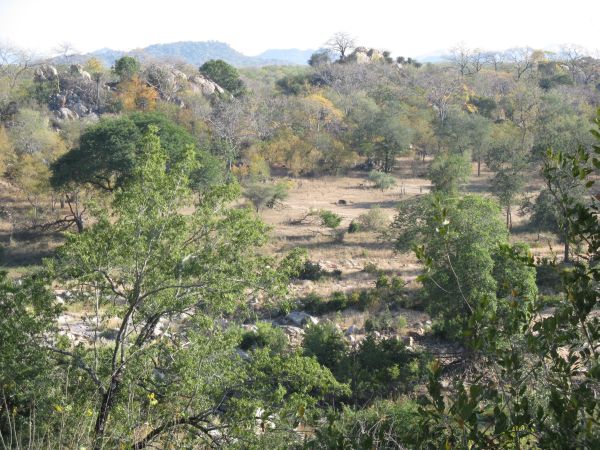 The view from my cottage
The view from my cottage
From
the gate to Ingwe Lodge is 38 Kms, taking about 50 minutes driving.
Let me explain: SVC covers 3,250 Km2,and is divided into 23 game
ranches. Five ranches were taken over by the “war vets” in the early
2000s, and are now occupied by hundreds of farmers, although this
area, with poor soils and erratic and low rainfall, is not suitable
for subsistence agriculture We were headed for Sango Ranch (16,000
ha.) where L & N manage Ingwe Game Lodge. The lodge consists of
six main cottages, which normally cost US $600 per night ($1,400 per
night for hunters, who in addition pay hunting fees ranging from
$25,000 for an elephant to $800 for an impala). SVC seems a
neo-colonial anachronism: all ranches are owned by whites, and all
senior management, and the clients, are whites. There are a few African
“PHs” (Professional hunters) in Zimbabwe, but none, as far as I could
make out, operate in SVC, Because SVC is privately owned, the Government
receives no fees. The owners feel threatened; some Africans visited
one ranch, saying: We have come to introduce ourselves, we are
your new partners. Apparently
they were predicting that the proposed law, granting 51% control of
all businesses to Zimbabweans ( presumably black Zimbabweans?) would
be passed.
Ingwe
lodge employs a staff of 11, who work for 48 days, then have 12 days
leave. One afternoon I accompanied Nevin who drove to the gate on
the main road, to collect Lovemore, who had returned from leave at
his home in Kariba, 800 kms away, a two day bus journey, if the buses
are operating. The staff were all pleasant and friendly, perhaps it
was because jobs are scarce in Zimbabwe. In the early 2000s, the property
where L & N were working, in northern Zimbabwe, was taken over,
and they moved to Zambia, where they worked – through a combination
of unfortunate circumstances -
at six different locations, I visited them at five of these
places, (Lindsay’s father, my brother Paul, died in 1986, since when
I have been informally in loco parentis for his four children).
Apart from the pleasure of seeing them, each visit afforded me unforgettable
days in the bundu : Nevin ,with forty years experience of wildlife, first as a Game Ranger,
then as a PH, is – as Bernard used to say – “the best African naturalist
I know”. I came to recognize that it is not a contradiction for him
to be both a PH and an ardent conservationist. As a PH, Nevin guides
wealthy clients, does not shoot himself unless necessary, for example
to protect a client.
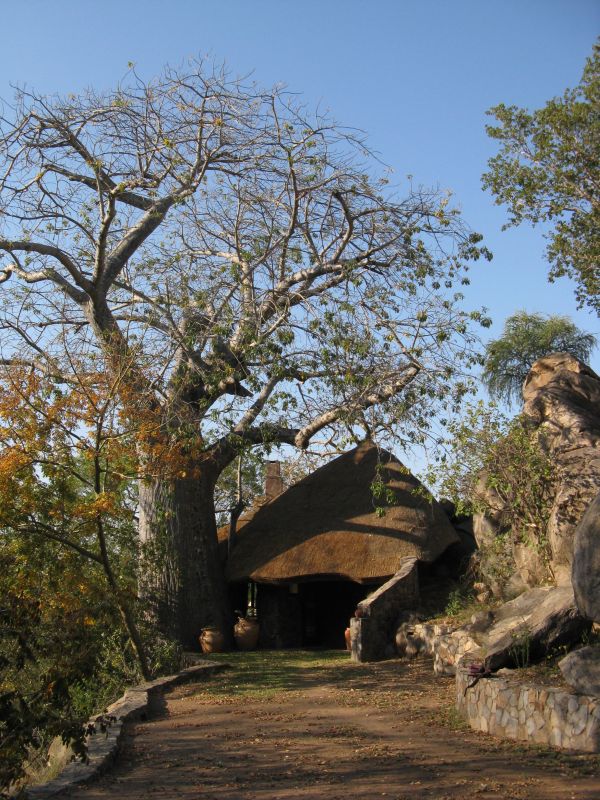 Baobab Cottage
Baobab Cottage
Sango
Ranch is owned by a wealthy German, who has spared no expense to make
the lodge comfortable, rather OTT for the bundu. But the wildlife
is not as well served as the guest, as I saw when driving around.
Water holes were often disused, when simple repairs would have worked,
which caused Nevin frequently to wince, and swear. He had no authority
over wildlife, despite his experience: he was simply co-manager of
the lodge. The ranch owner, who visits two or three times a year,
allows L & N to have their own guests when the lodge is empty,
which is why I visited at this time, my window of opportunity. Although
L & N could have eaten in style at the lodge, they preferred (I
also) to have simple meals in their own cottage. During my stay,
I had two particular pleasures at the lodge. First, I slept with the
sliding doors wide open, which I dare not do in South Africa. Second,
when we had our sundowners on the lawn, I could gaze up at the Southern
Cross, which is not visible where I live in Fish Hoek, because of
the urban lights. We usually saw at least one satellite, too.
I remembered how often Bernard and I had looked at the heavens,
he patiently identifying the constellations for me.
May
6 to May 13
On every one of these days,
Nevin took me for a game drive, usually of a few hours, including
some night drives, During this period, I saw 70 spp of birds, including
several new to me, and I recognised some old bird friends from Kenya
in the 1970s, when Bernard and I were keen birders. I should confess
that I often relied on Nevin first to spot the bird, then to identify
it. I saw four of the “Big Five”, missing only leopard, More important,
most of the sightings were close encounters: Nevin knew precisely
how close was a safe distance. We saw: three male lions at a waterhole;
several herds of elephant, one herd being uncomfortably
- and thrillingly – close; a good group of buffalo; best of
all, we saw a white rhino female, with a calf, which Nevin guessed
was just one week old. It was the size of a medium warthog, trotting
alongside its mother. The estimated rhino population in Sango Ranch is 80, 60 black rhino, 20 white;
these are seriously threatened by poachers. A local man might receive
$4000 for a 2 kg. rhino horn, a huge sum when a good monthly wage
is $150. The same horn would fetch $150,000+ in China. The situation
was not helped when a Vietnamese general announced that his cancer
had been cured by powdered rhino horn. “Traditional poaching”, by
local people from the neighbouring poor, crowded settlements,
for “bush meat”, is much less harmful. While I was in Zimbabwe,
it was announced that
President Mugabe was giving two of each species of animal
in Hwange National Park to the government of North Korea, as
“a gift”. Hmm! Appropriate that these two pariah states should be close.
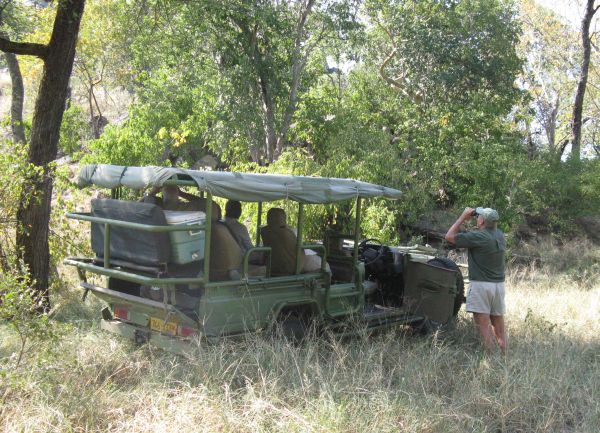 Game
Drive with Nevin Game
Drive with Nevin
In addition,
we saw a variety of antelopes, from the dainty Klipspringer to the
huge Eland, including Sable, Waterbuck, Kudu, Sharpe’s Grysbok, Bushbuck,
Nyala and Impala galore. Other sightings included : Giraffe, black-backed
Jackal, Warthog, Bush pig, Zebra and Wildebeest (both very common, they were culled each year),
Bush baby, dwarf Mongoose,
Baboon, Vervet Monkey. For me the second highlight (after the
rhino calf) was a pack of wild dogs, which I had only once seen earlier
– in Zambia. A third highlight was watching two
groups of dwarf mongoose fighting over an anthill, the tiny
victors busily marking their new territory with urine, and by rubbing
their backsides against the shrubs on the anthill
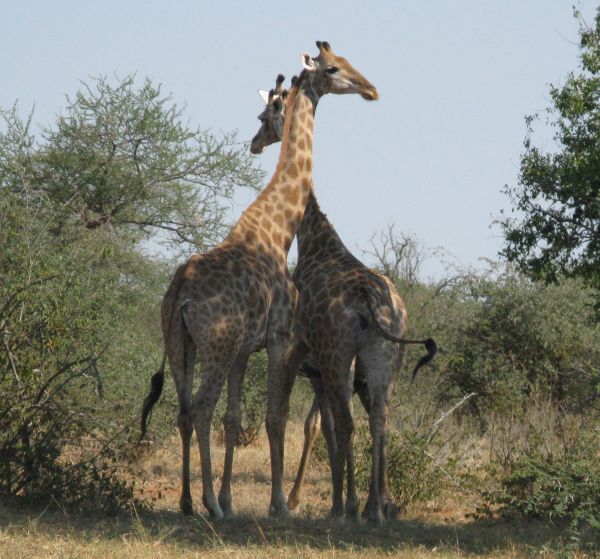 Giraffes Giraffes
Saturday May 8. L
& N have no TV, so we drove, one hour, to Leon’s home to watch
a rugby game – The Western Cape Stormers vs, the Kwa/Zulu
Natal Sharks, for those of you who follow the “Super 14” rugby
league (the Sharks, surprisingly, won, 20 to 14). After several beers
(no highway cops on the ranch) and a braai, we drove back,
our spotlight finding many animals.
The
British General Election had been held two days earlier, and I was
eager for TV news, but I did not persist, recognising that rugby triumphed
distant politics. People who live in such places tend to have a very
deep, but narrow, knowledge of the world. I am not being
patronising, I respect such depth.
Sunday May 9 . A couple from Mutare, friends of L & N,
were visiting for the week-end, so we all drove to the Sabe
River for a picnic, finding an ideal spot, with shade and good views
and good birding. On the way we passed a dam which abounded in bird
life, storks, ducks, geese, raptors (including an African Fish Eagle,
jacana… .
It
was on the return journey that we saw the wild dogs, and Nevin once
again astounded me when we caught the merest blurry glimpse of a bird,
in deep dusk, and Nevin said it was a fiery-necked nightjar – and
nightjars are very difficult to distinguish, even when clearly seen.
(I did not include this bird in my tally: I counted only those that
I could identify on my own).
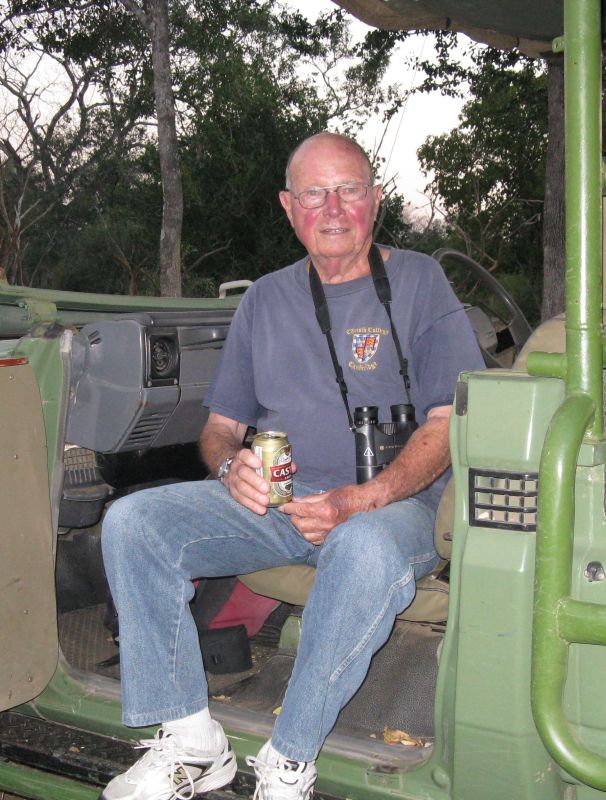 Sundowner
Sundowner
Friday May 14.
L, N and I left
early, 06:00, for the drive to Harare – for me to fly home the next
day, and for them to stock up with supplies, and also to see their
younger son Daryl and his family. By 07:00
we were
driving along the main road, passing lines of children on their way
to school, mostly primary, some to
high schools. Some of them, especially the younger ones were
barefoot, but all were neatly dressed in their red, blue or green
school uniforms, and seemed cheerful, waving to us – there was little
traffic on the road.
Of the 101 unanswered questions I had were these: “How do the (mostly
poor, judging from the houses and cultivated plots) parents manage the school fees? What are the standards
of the rural schools? Are the teachers regularly paid? The fact
that I have no answers indicates how superficial are my observations.
Arriving
in Harare after 5 & ½ hours driving, I was dropped at York Lodge,
which had been recommended by friends, and which proved to be truly
“ a place of cool repose”. Set in extensive and well-kept gardens,
with abundant plumbago
and bougainvillea,
the cottages were extremely comfortable, and not at all OTT. I had arranged to
meet Niki Jazdowska there for lunch, which we had on the terrace.
While having lunch, we heard the receptionist saying that men
at the gate, claiming to be police, were demanding to see the guest
register, A couple of years ago, foreign journalists, staying at York
Lodge, had been arrested and deported. Niki, who had experienced such
encounters, told the hotel staff to refuse entry unless the “police”
produced a Court Warrant – which worked. Niki – and others – told
me that one welcome change these days, as opposed to early 2000s,
was that one could be assertive and not get thrown in jail. Another,
more pleasant distraction over lunch was the visit of
Alice Chikonodanga, whose father, Gift, does for me every Tuesday,
08:00 to 10:00. Gift had asked me to take some money (South African
Rands, which, with US $$$s, are the accepted currency in Zimbabwe)
to Alice, who lived in a township the other side of Harare. Niki was
able, using cell phones,
to guide Alice, who had to take three different buses, to York Lodge.
When
Bernard and I were living in Sherborne, Dorset, and preparing to leave
for Cape Town, Krysia, an elderly Polish lady, whom we knew from the
Catholic church, asked us to contact her old friend Stenia Jazdowski,
who spent three months each year in Cape Town. Amazingly, Stenia stayed
at an apartment in Fish Hoek, three doors away from us, and through
her we met her daughter, Niki a sociologist who is working with a
health NGO in Harare. Niki and I talked for hours until we
tired the sun with talking, and sent him down the sky.
Niki, a Zimbabwean citizen, has lived there for most of her life,
and has a good knowledge of what is going on.
That
evening I took L & N and Daryl
to dinner at The Blue Banana, a popular, excellent and
inexpensive restaurant, with both
black and white customers. Back at the lodge, we had a nightcap
at the “honesty bar”.
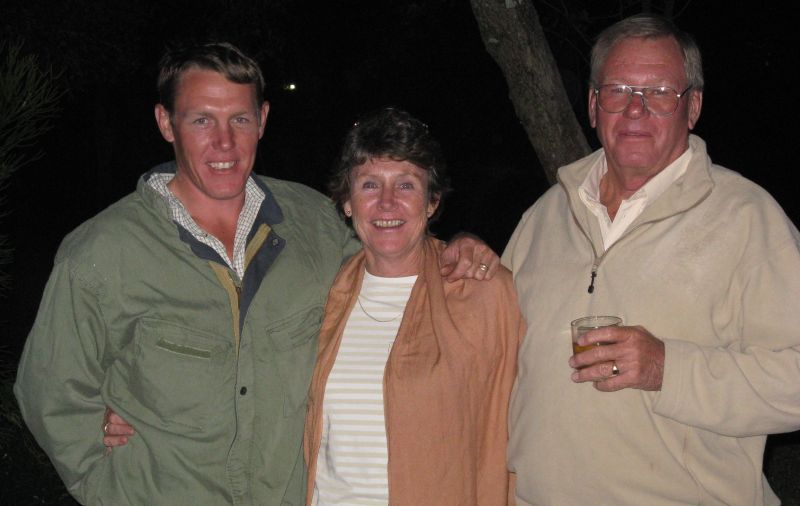
Daryl, Lindsay & Nevin
Saturday
May 15. Another
early start, with a 05:00 departure for the airport. I had asked for
transport, expecting to see a battered taxi arrive, but Richard, the
smiling young son of the owner, drove me in their 4x4.
All
my flights, and all my border crossings, were trouble free, I was
back in Cape Town International Airport a 11:00. Many of the passengers,
on all my flights were Chinese, speaking little English and keeping
to themselves. This was a very good trip. I have told you little about
“the real Zimbabwe”. If you would like to know more, do read Petina
Gappah’s collection of short stories, An Elegy for Easterly
(2010). Gappah, a lawyer, lives in Geneva.
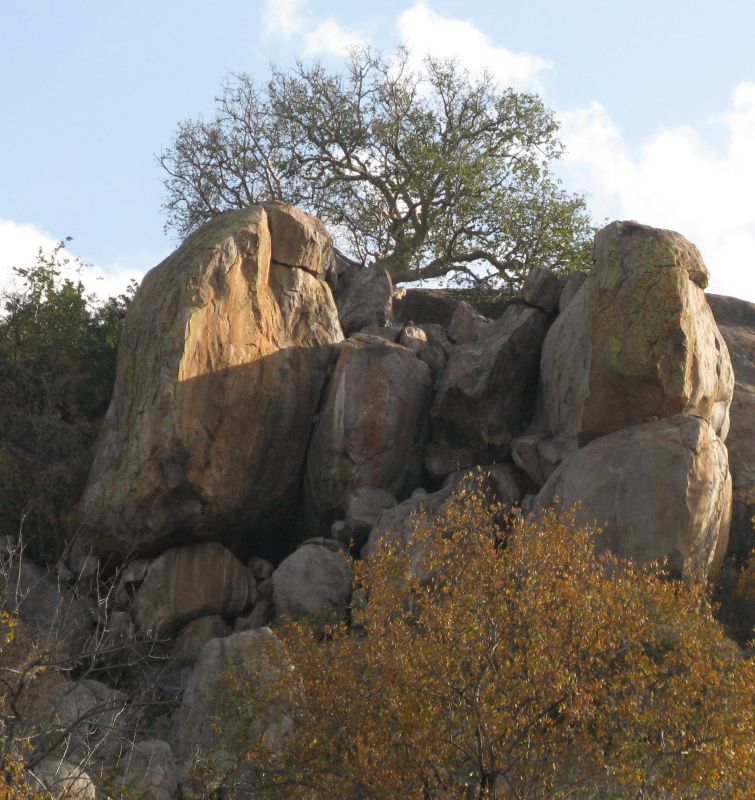
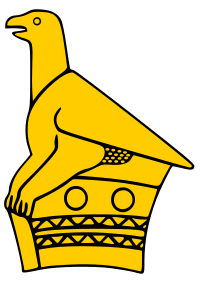
|
|
|